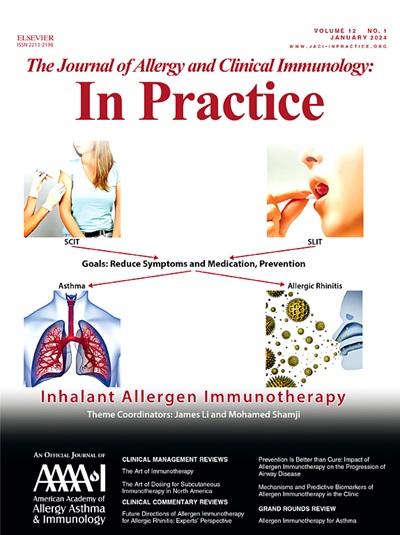慢性自发性荨麻疹与慢性诱导性荨麻疹的临床评价及疗效评价。
IF 6.6
1区 医学
Q1 ALLERGY
Journal of Allergy and Clinical Immunology-In Practice
Pub Date : 2025-09-01
DOI:10.1016/j.jaip.2025.07.008
引用次数: 0
摘要
慢性自发性荨麻疹(CSU)和慢性诱导性荨麻疹(CIndU)是一种衰弱性皮肤病,其特征是反复出现瘙痒性皮疹和/或血管性水肿,对患者的生活质量(QoL)有相当大的负面影响。准确的临床评价对诊断、疾病监测和指导治疗具有重要意义。在CSU,它主要基于详细的病史,选定的实验室调查和患者报告的结果测量(PROMs)。在CIndU中,客观激发测试和临界阈值测试(CTT)也很有用。从患者的角度来看,PROMs已经成为评估疾病活动、影响和控制的不可或缺的工具。它们加强疾病监测,支持治疗决策,促进个性化,以患者为中心的护理,并被推荐用于常规临床护理和研究。最近,数字工具,如CRUSE®应用程序有进一步先进的PROM集成,实现实时疾病跟踪和改善临床工作流程。在CIndU中,客观激发试验和CTT有助于确定特定的触发因素和量化个体刺激阈值。基于“评估-行动-调整”原则的结构化方法通过将胎膜早破结果、诊断测试(如CTT)和其他数据与治疗策略联系起来,促进了最佳管理。它在荨麻疹护理中的实施支持个性化医疗,旨在实现完全的疾病控制并使患者的生活质量正常化。本文章由计算机程序翻译,如有差异,请以英文原文为准。
Clinical Evaluation and Outcome Measures of Chronic Spontaneous Urticaria and Chronic Inducible Urticaria
Chronic spontaneous urticaria (CSU) and chronic inducible urticaria (CIndU) are debilitating skin diseases characterized by recurrent itchy wheals and/or angioedema, with a considerable negative impact on the patient’s quality of life (QoL). Accurate clinical evaluation is important for diagnosis, disease monitoring, and guiding treatment. In CSU, it is primarily based on a detailed history, selected laboratory investigations, and patient-reported outcome measures (PROMs). In CIndU, objective provocation tests and critical threshold testing (CTT) are additionally useful. PROMs have emerged as indispensable tools in assessing disease activity, impact, and control from the patient’s perspective. They enhance disease monitoring, support treatment decisions, and facilitate individualized, patient-centered care, and are recommended in routine clinical care and research. Recently, digital tools such as the CRUSE (Chronic Urticaria Self Evaluation) app have further advanced PROM integration, enabling real-time disease tracking and improved clinical workflows. In CIndU, objective provocation tests and CTT help to identify specific triggers and quantify individual stimulus thresholds. A structured approach based on the "Assess–Act–Adjust" principle facilitates optimal management by linking PROM results, diagnostic tests (eg, CTT), and other data with therapeutic strategies. Its implementation in urticaria care supports personalized medicine, aiming to achieve complete disease control and to normalize the patient’s QoL.
求助全文
通过发布文献求助,成功后即可免费获取论文全文。
去求助
来源期刊

Journal of Allergy and Clinical Immunology-In Practice
ALLERGYIMMUNOLOGY-IMMUNOLOGY
CiteScore
11.10
自引率
9.60%
发文量
683
审稿时长
50 days
期刊介绍:
JACI: In Practice is an official publication of the American Academy of Allergy, Asthma & Immunology (AAAAI). It is a companion title to The Journal of Allergy and Clinical Immunology, and it aims to provide timely clinical papers, case reports, and management recommendations to clinical allergists and other physicians dealing with allergic and immunologic diseases in their practice. The mission of JACI: In Practice is to offer valid and impactful information that supports evidence-based clinical decisions in the diagnosis and management of asthma, allergies, immunologic conditions, and related diseases.
This journal publishes articles on various conditions treated by allergist-immunologists, including food allergy, respiratory disorders (such as asthma, rhinitis, nasal polyps, sinusitis, cough, ABPA, and hypersensitivity pneumonitis), drug allergy, insect sting allergy, anaphylaxis, dermatologic disorders (such as atopic dermatitis, contact dermatitis, urticaria, angioedema, and HAE), immunodeficiency, autoinflammatory syndromes, eosinophilic disorders, and mast cell disorders.
The focus of the journal is on providing cutting-edge clinical information that practitioners can use in their everyday practice or to acquire new knowledge and skills for the benefit of their patients. However, mechanistic or translational studies without immediate or near future clinical relevance, as well as animal studies, are not within the scope of the journal.
 求助内容:
求助内容: 应助结果提醒方式:
应助结果提醒方式:


